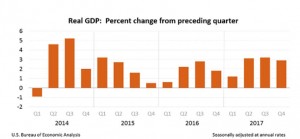March 28, 2018
Estimates released by the Bureau of Economic Analysis, show an increase in real gross domestic product (GDP) at an annual rate of 2.9 percent in the fourth quarter of 2017, a marginal decrease from the 3.2 percent recorded in the third quarter.
The slowdown in real GDP growth rate in the fourth quarter reflected a downturn in private inventory investment that was partly offset by accelerations in PCE, exports, state and local government spending, non-residential fixed investment, and federal government spending, and an upturn in residential fixed investment.
Import also increased, which added to the deceleration in real GDP growth. However, the increase in real GDP in the fourth quarter primarily reflected positive contributions from PCE, non-residential fixed investment, exports, residential fixed investment, state and local government spending, and federal government spending that were partly offset by a negative contribution from private inventory investment.
“For the fourth quarter, the general picture of economic growth remains the same, even-though personal consumption expenditures (PCE) and private inventory investment were revised up,” the Bureau added.
All inflation indicators were up for the fourth quarter. Domestic price index rose 2.5 percent in the fourth quarter versus a 1.7 percent increase in the third quarter, while personal consumption expenditure price index increased 2.7 percent. Core inflation- inflation excluding food and energy prices- increased 1.9 percent for the fourth quarter.
2017 GDP
For the calendar year 2017, real GDP increased by 2.3 percent. This reflected an increase of 1.2 percent higher than the 2016 increase of 1.5 percent. As stated by the Bureau, “the increase in real GDP in 2017 primarily reflected positive contributions from PCE, non-residential fixed investment, and exports. These contributions were partly offset by a decline in private inventory investment. Imports, which are a subtraction in the calculation of GDP, increased.”
Inflationary pressure continued in 2017. The price index for gross domestic purchases increased 1.8 percent in 2017, compared with an increase of 1.0 percent in 2016. The PCE price index increased 1.7 percent, compared with an increase of 1.2 percent. However, core inflation ( inflation excluding food and energy prices), increased 1.5 percent, compared with an increase of 1.8 percent in the previous period.

The information contained herein has been obtained from sources believed to be reliable, however its accuracy and completeness cannot be guaranteed. You are hereby notified that any disclosure, copying, distribution or taking any action in reliance on the contents of this information is strictly prohibited and may be unlawful. Mayberry may effect transactions or have positions in securities mentioned herein. In addition, employees of Mayberry may have positions and effect transactions in the securities mentioned herein.
